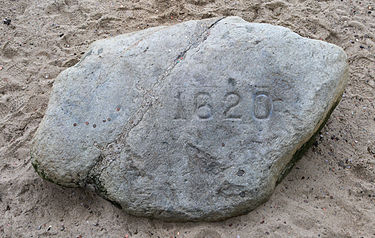Plymouth Rock
Plymouth Rock | |
 Plymouth Rock, inscribed with 1620, the year of the Pilgrims' landing in the Mayflower | |
| Location | Plymouth, Massachusetts |
|---|---|
| Coordinates | 41°57′30″N 70°39′43″W / 41.95833°N 70.66194°WCoordinates: 41°57′30″N 70°39′43″W / 41.95833°N 70.66194°W |
| NRHP Reference # | 70000680[1] |
| Added to NRHP | July 1, 1970 |

Plymouth Rock is the traditional site of disembarkation of William Bradford and the Mayflower Pilgrims who founded Plymouth Colony in 1620. It is an important symbol in American history. There are no contemporaneous references to the Pilgrims' landing on a rock at Plymouth, and it is not referred to in Edward Winslow's Mourt's Relation (1620–21) or in Bradford's journal Of Plymouth Plantation (1620–47).[2] The first written reference to the rock's existence was recorded in 1715, when it is described in the town boundary records as "a great rock."[3] The first written reference to Pilgrims landing on a rock is found 121 years after they landed, in 1741. A rock traditionally identified as Plymouth Rock has long been memorialized on the shore of Plymouth Harbor in Plymouth, Massachusetts.
Contents
[hide]History of Plymouth Rock[edit]
Plymouth Rock — geologically classified as a Dedham granodiorite boulder and a glacial erratic — had lain at the foot of Cole's Hill from generation to generation until the century after the Pilgrims' landing in 1620. When plans were afoot to build a wharf at the Pilgrims' landing site in 1741, a 94-year-old elder of the church named Thomas Faunce, then living three miles from the spot, declared that he knew the precise boulder on which the Mayflower pilgrims first stepped when disembarking.[4] As recounted in the 1897 book, The Story of the Pilgrim Fathers, the standard story goes:
The real Plymouth Rock was a boulder about fifteen feet long and three feet wide which lay with its point to the east, thus forming a convenient pier for boats to land during certain hours of tide. This rock is authenticated as the pilgrims' landing place by the testimony of Elder Faunce who in 1741 at the age of ninety-five was carried in a chair to the rock, that he might pass down to posterity the testimony of pilgrims whom he had personally known on this important matter.[5]
Faunce's father had arrived at the colony aboard the Anne in 1623, more than 2 years after the Mayflower landing, and Elder Faunce himself had been born in 1647, but Faunce insisted that not only his father but several of the original Mayflower passengers had, when he was a youth, identified the precise rock to him. Faunce was brought in a chair to the shore, in the presence of most of the town, and he reportedly began weeping at what he was sure would be his last sight of the rock, which he identified. Although Faunce identified the rock in 1741, it was not moved from the shore until 1774.[4]
There have been doubts hinted about the accuracy of Faunce's identification, in view of his age and the dates of the landing and his birth, but there is no doubt that he grew up in Plymouth at a time when many of the original passengers were still there. The Pilgrims first landed, however, near the site of modern Provincetown on the tip of Cape Cod in November 1620 before moving to Plymouth. The rock is located about 650 feet (200 m) from where it is generally accepted that the initial settlement was built, on nearby Leyden Street leading up toward Burial Hill.[6]
Bill Bryson questions the story in Made in America,[7]
The one thing the Pilgrims certainly did not do was step ashore on Plymouth Rock. Quite apart from the consideration that it may have stood well above the high-water mark in 1620, no prudent mariner would try to bring a ship alongside a boulder on a heaving December sea when a sheltered inlet beckoned from near by.
— Bill Bryson, Made in America

Movements[edit]
When Col. Theophilus Cotton (son of Josiah Cotton, a Plymouth magistrate) and the townspeople of Plymouth decided to move the rock in 1774, the rock was split into two parts, with the bottom portion left behind at the wharf and the top portion being relocated to the town's meeting house.
Captain William Coit wrote in the Pennsylvania Journal of November 29, 1775, of a story of how he brought captive British sailors ashore "upon the same rock our ancestors first trod."
The upper portion of the rock was later relocated from Plymouth's meetinghouse to Pilgrim Hall in 1834. In 1859, the Pilgrim Society began building a Victorian canopy, designed by Hammett Billings, at the wharf over the lower portion of the rock. Following the structure's completion in 1867, the top of the rock was moved from Pilgrim Hall back to its original wharf location in 1880 and rejoined to the lower portion. The date "1620" was carved into the rock.[6]
In 1920, the rock was found[clarification needed] and the waterfront rebuilt to a design by noted landscape architect Arthur Shurcliff, with a waterfront promenade behind a low seawall, in such a way that when the rock was returned to its original site, it would be at water level. The care of the rock was turned over to the Commonwealth of Massachusetts, and a new very sober Roman Doric portico designed by McKim, Mead and White for viewing the tide-washed rock protected by gratings.[6]
During the rock's many journeys throughout the town of Plymouth, numerous pieces were taken, bought and sold. Today approximately 1⁄3 of the top portion remains.[8] It is estimated that the original Rock weighed 20,000 lb (9,100 kg). Although some documents indicate that tourists or souvenir hunters chipped it down, no pieces have been noticeably removed since 1880. Today there are pieces in Pilgrim Hall Museum as well as in the Patent Building in the Smithsonian.[6] In 1835 Alexis De Tocqueville, a French author traveling throughout the United States, wrote,
This Rock has become an object of veneration in the United States. I have seen bits of it carefully preserved in several towns in the Union. Does this sufficiently show that all human power and greatness is in the soul of man? Here is a stone which the feet of a few outcasts pressed for an instant; and the stone becomes famous; it is treasured by a great nation; its very dust is shared as a relic.[9]
A great piece of the Rock is set on a pedestal in the cloister of historic Plymouth Church of the Pilgrims on Brooklyn Heights. The Church, formed by a merger of Plymouth Church and Church of the Pilgrims, was once pastored by Henry Ward Beecher.
20th century[edit]
Cole Porter makes a comic allusion to Plymouth Rock in the title song of the 1934 musical Anything Goes, imagining that if Puritans were to object to "shocking" modern mores, instead "of landing on Plymouth Rock, Plymouth Rock would land on them." Malcolm X repeated the imagery in a speech on black nationalism, saying, "We didn't land on Plymouth Rock. The rock was landed on us."[10]
Plymouth Rock has figured prominently in Native American politics in the United States, particularly as a symbol of wars starting with King Philip's War, known as the First Indian War, from 1675-78. It has been ceremoniously buried twice by Native American rights activists, once in 1970 and again in 1995, as part of National Day of Mourning protests.[11]
Current status[edit]
Today Plymouth Rock is managed by the Department of Conservation and Recreation for the Commonwealth of Massachusetts as part of Pilgrim Memorial State Park. From the end of May to Thanksgiving Day, Pilgrim Memorial is staffed by park interpreters who inform visitors of the history of Plymouth Rock and answer questions.
Panorama[edit]
See also[edit]
'Massachusetts' 카테고리의 다른 글
| Chester, Massachusetts (0) | 2016.08.05 |
|---|---|
| Provincetown, Massachusetts (0) | 2016.06.23 |
| Mohawk Trail (0) | 2016.03.23 |
| Harvard University (2) | 2015.05.09 |
| Walden Pond (0) | 2015.05.05 |




